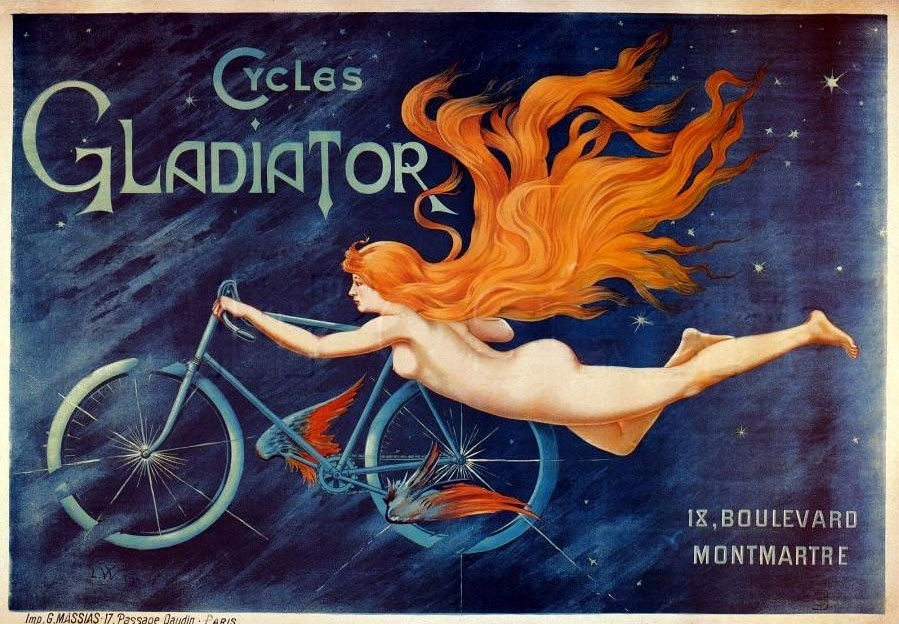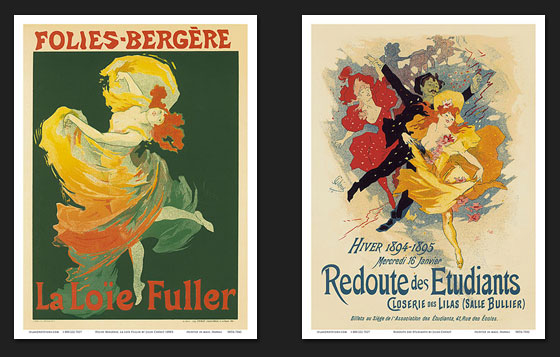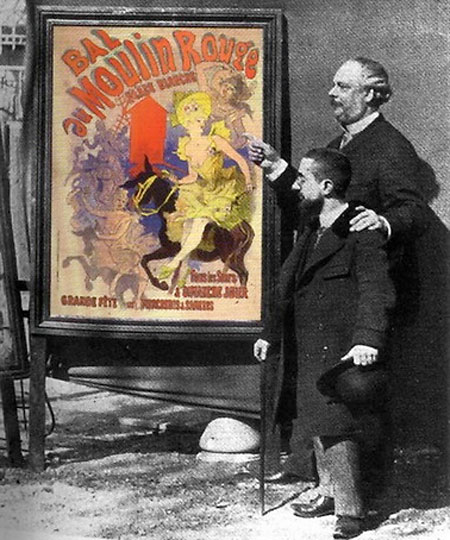Archive for November, 2014
The History of Poster Art over the last two Centuries. Part 3
…..continued from our ongoing exploration on the History of Poster Art over the last two centuries. In Part 2 of this Blog I introduced Jules Chéret, “the father of the modern poster” and his publication “Maitres de l’Affiche”. Next I want to focus on some of the artists that were featured in this publication that promoted the poster as an independent art form.
Alphonse Mucha, Eugène Grasset and Théophile Steinlen were influential poster designers of this generation, known for their Art Nouveau style and stylized figures, particularly of women. Advertisement posters became a special type of graphic art in the modern age. These three artists, along with many others, were part of a circle of artists whose art form transferred to magazines for advertising as well as for social and political commentary.
Alphonse Mucha (1860-1939)
 Alphonse Mucha was a Moravian (Czechoslovakia) painter of the late 19th and early 20th centuries. He started his career working at decorative painting jobs in Moravia, mostly designing theatrical scenery. His employer was very much inspired by his work and sponsored Mucha’s formal training at the Munich Academy of Fine Arts. Afterwards Mucha went to Paris for further studies. Mucha has a significant role in the Art Nouveau movement and created pieces that have achieved classic status. He was the creator of numerous paintings, illustrations, advertisements, postcards and designs which became an inspiration for many artists of his time. He invested many years of his life creating his fine art masterpiece, The Slav Epic. It contained twenty huge paintings that illustrated the history of the Czech and the Slavic people which was donated to the city of Prague in 1928.
Alphonse Mucha was a Moravian (Czechoslovakia) painter of the late 19th and early 20th centuries. He started his career working at decorative painting jobs in Moravia, mostly designing theatrical scenery. His employer was very much inspired by his work and sponsored Mucha’s formal training at the Munich Academy of Fine Arts. Afterwards Mucha went to Paris for further studies. Mucha has a significant role in the Art Nouveau movement and created pieces that have achieved classic status. He was the creator of numerous paintings, illustrations, advertisements, postcards and designs which became an inspiration for many artists of his time. He invested many years of his life creating his fine art masterpiece, The Slav Epic. It contained twenty huge paintings that illustrated the history of the Czech and the Slavic people which was donated to the city of Prague in 1928.
Though Mucha’s works were stamped outdated after his death, his works have now become something to look for inspiration for the illustrators and artists today.

Alphonse Mucha; JOB Cigarette Rolling Paper, Monaco- Monte- Carlo
Eugène Samuel Grasset (1845–1917)
 Eugène Samuel Grasset was a Swiss decorative artist who worked in Paris, France in a variety of creative design fields during the Belle Époque. He is considered a pioneer in Art Nouveau design.
Eugène Samuel Grasset was a Swiss decorative artist who worked in Paris, France in a variety of creative design fields during the Belle Époque. He is considered a pioneer in Art Nouveau design.
He studied drawing and in 1861 went to Zurich to study architecture. After completing his education, he visited Egypt, an experience that would later be reflected in a number of his poster designs. He became an admirer of Japanese art, which influenced some of his designs.
In 1877 Eugène Grasset turned to graphic design, producing income-generating products such as postcards and eventually postage stamps for both France and Switzerland. However, it was poster art that quickly became his forte. Some of his works became part of the “Les Maîtres de l’Affiche” publication including his lithograph, “Jeanne d’Arc Sarah Bernhardt.”
With the growing popularity of French posters in the United States, Grasset was soon contacted by several American companies. In the 1880s, he did his first American commission and more success led to cover designs for Harper’s Magazine. Grasset’s work for U.S. institutions helped pave the way for Art Nouveau to dominate American art.
At the Universal Exhibition of 1900 in Paris, the G. Peignot et Fils typefoundry, introduced the “Grasset” typeface, an Italic design Eugène Grasset created in 1898 for use on some of his posters.

Eugene Grasset (Salon des Cent).
Théophile Alexandre Steinlen (1859 – 1923)
Théophile Alexandre Steinlen was a Swiss-born French Art Nouveau painter and printmaker.
In his early twenties he was still developing his skills as a painter when he and his new wife moved to the artistic community in the Montmartre Quarter of Paris. Montmartre and its environs, was a favorite subject throughout Steinlen’s life and he often painted scenes of some of the harsher aspects of life in the area. In addition to paintings and drawings, he also did sculpture on a limited basis, most notably figures of cats that he had great affection for as seen in many of his paintings.
Steinlen became a regular contributor to Le Rire and Gil Blas magazines plus numerous other publications including L’Assiette au Beurre and Les Humouristes, a short-lived magazine he and a dozen other artists jointly founded in 1911. Between 1883 and 1920, he produced hundreds of illustrations, a number of which were done under a pseudonym so as to avoid political problems because of their harsh criticisms of societal ills.
Théophile Steinlen died in 1923 in Paris and was buried in the Cimetière Saint-Vincent in Montmartre. Today, his works can be found at many museums around the world including at the Hermitage Museum in St. Petersburg, Russia. and the National Gallery of Art in Washington, D.C., United States.

Théophile Steinlen’s iconic poster for the theater troupe “Chat Noir” designed in 1896. A portrait of the artist in his studio; engraving by Pieter Dupont (1901).
To be continued… thanks for visiting our blog, your feedback is appreciated.
Bernard Lassalle
bernard@classicvintageposters.com
The History of Poster Art over the last two Centuries. Part 2

By the 1890s, poster art had widespread usage in other parts of Europe, advertising everything from bicycles to cigarette rolling papers, and bullfights. By the end of the 19th century, during an era known as the Belle Époque, the standing of the poster as a serious art form was raised even further.
Between 1895 and 1900, Jules Chéret created the “Maîtres de l’Affiche” (Masters of the Poster) series that became not only a commercial success, but is now seen as an important historical publication.
The publication consisted of 256 color lithographic plates reproduced from the original works of ninety-seven artists in a smaller 11 x 15 inch format.
The varied selection of prints were sold in packages of four and delivered monthly to subscribers. On sixteen occasions during the selling period between December 1895 through November 1900, the monthly package included a bonus of a specially created lithograph.

Jules Chéret, “Folies Bergeres” and “Redoute des Etudiants”
Jules Chéret (1836 -1932)

Jules Chéret was a French painter and lithographer who became a master of Belle Époque poster art. He has been called the father of the modern poster. At age thirteen, he began a three-year apprenticeship with a lithographer and then his interest in painting led him to take an art course at the École Nationale de Dessin. Like most other fledgling artists, Chéret studied the techniques of various artists, past and present, by visiting Paris museums. From 1859 to 1866, he was trained in lithography in London, England, where he was strongly influenced by the British approach to poster design and printing.
On returning to France, Chéret created vivid poster ads for the cabarets, music halls, and theaters such as the Eldorado, the Olympia, the Folies Bergère, Théâtre de l’Opéra, the Alcazar d’Été and the Moulin Rouge. He created posters and illustrations for the satirical weekly Le Courrier français.
In 1895, Chéret created the Maîtres de l’Affiche collection, a significant art publication of smaller sized reproductions featuring the best works of ninety-seven Parisian artists. His success inspired an industry that saw the emergence of a new generation of poster designers.

Jules Chéret, “Pantomimes Lumineuses”
To be continued…
Thank you for reading this blog, your feedback is appreciated!
The History of Poster Art over the last two Centuries. Part 1

The modern poster, as we know it, dates back to 1870 when the printing industry perfected color lithography and made mass production possible.
Posters have come to be recognized as a vital art form, attracting artists at every level, from painters to theatrical and commercial designers and they have shown a great range of styles. Posters, in the form of placards and posted bills, have been used since earliest times, primarily for advertising and announcements. Purely textual posters have a long history: they made citizens aware of government or church proclamations for centuries.

Martin Luther nails his reformist theses at All Saints Church in Wittenberg, Germany, 1517
However, the great revolution in posters was the development of printing techniques that allowed for cheap mass production and printing, including notably the lithographic technique which was invented in 1796 by the German Alois Senefelder. The invention of lithography was soon followed by chromolithography, which allowed for mass editions of posters illustrated in vibrant colors to be printed.
By the 1890s, the technique had spread throughout Europe. A number of noted French artists created poster during this period. Jules Chéret is considered to be the “father” of advertisement placards. He was a pencil artist and a scene decorator, who founded a small lithography office in Paris in 1866. He used striking characters, contrast and bright colours, and created over 1000 advertisements, primarily for exhibitions, theatres, and products. The industry soon attracted the service of many aspiring painters who needed a source of revenue to support themselves.

Chéret developed a new lithographic technique that suited better the needs of advertisers: he added a lot more color which, in conjunction with innovative typography, rendered the poster much more expressive. Not surprisingly, Chéret is said to have introduced sex in advertising or, at least, to have exploited the feminine image as an advertising ploy. In contrast with those previously painted by Toulouse-Lautrec, Chéret’s laughing and provocative feminine figures meant a new conception of art as being of service to advertising.

Jules Chéret and Toulouse- Lautrec (with cane), ca. 1894
Posters soon transformed the thoroughfares of Paris into the “art galleries of the street.” Their commercial success was such that some of the artists were in great demand and theatre stars personally selected their own favorite artist to do the poster for an upcoming performance. The popularity of poster art was such that in 1884 a major exhibition was held in Paris.
To be continued…